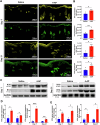4-aminopyridine attenuates inflammation and apoptosis and increases angiogenesis to promote skin regeneration following a burn injury in mice
- PMID: 39366954
- PMCID: PMC11452548
- DOI: 10.1038/s41420-024-02199-6
4-aminopyridine attenuates inflammation and apoptosis and increases angiogenesis to promote skin regeneration following a burn injury in mice
Abstract
Severe thermal skin burns are complicated by inflammation and apoptosis, which delays wound healing and contributes to significant morbidity. Diverse treatments demonstrate limited success in mitigating these processes to accelerate healing. Agents that alter cell behavior to improve healing would alter treatment paradigms. We repurposed 4-aminopyridine (4-AP), a drug approved by the US FDA for multiple sclerosis, to treat severe burns in mice (10-week-old C57BL/6 J male mice weighing 25 ± 3 g). We found that 4-AP, in the early stages of burn healing, significantly reduced the expression of pro-inflammatory cytokines IL1β and TNFα while increasing the expression of anti-inflammatory markers CD206, ARG-1, and IL10. We demonstrated increased intracellular calcium effects of 4-AP through Orai1-pSTAT6 signaling, where 4-AP significantly mitigated inflammatory effects by promoting M2 macrophage differentiation in in-vitro macrophages and post-skin burn tissues. 4-AP attenuated apoptosis, with decreases in apoptotic markers BAX, caspase-9, and caspase-3 and increases in anti-apoptotic markers BCL2 and BCL-XL. Furthermore, 4-AP promoted angiogenesis through increases in the expression of CD31, VEGF, and eNOS. Together, these likely contributed to accelerated burn wound closure, as demonstrated in increased keratinocyte proliferation (K14) and differentiation (K10) markers. In the later stages of burn healing, 4-AP increased TGFβ and FGF levels, which are known to mark the transformation of fibroblasts to myofibroblasts. This was further demonstrated by an increased expression of α-SMA and vimentin, as well as higher levels of collagen I and III, MMP 3, and 9 in mice treated with 4-AP. Our findings support the idea that 4-AP may have a novel, clinically relevant therapeutic use in promoting burn wound healing.
© 2024. The Author(s).
Conflict of interest statement
PKG and JCE are inventors on patents 1). Methods and materials for treating burns (US18/139,123); (2). Methods and materials for treating hair loss (US18/270,914); 3). Methods and materials for treating nerve injury and/or promoting wound healing (US17/759,224) submitted by the Penn State Research Foundation. All other authors declare that they have no competing financial interests.
Figures








Update of
-
4-aminopyridine attenuates inflammation and apoptosis and increases angiogenesis to promote skin regeneration following a burn injury.Res Sq [Preprint]. 2024 Aug 1:rs.3.rs-4669610. doi: 10.21203/rs.3.rs-4669610/v1. Res Sq. 2024. Update in: Cell Death Discov. 2024 Oct 4;10(1):428. doi: 10.1038/s41420-024-02199-6. PMID: 39149501 Free PMC article. Updated. Preprint.
Similar articles
-
4-aminopyridine attenuates inflammation and apoptosis and increases angiogenesis to promote skin regeneration following a burn injury.Res Sq [Preprint]. 2024 Aug 1:rs.3.rs-4669610. doi: 10.21203/rs.3.rs-4669610/v1. Res Sq. 2024. Update in: Cell Death Discov. 2024 Oct 4;10(1):428. doi: 10.1038/s41420-024-02199-6. PMID: 39149501 Free PMC article. Updated. Preprint.
-
Topical Delivery of 4-Aminopyridine Enhances Skin Regeneration in Burn Wounds.bioRxiv [Preprint]. 2025 Jun 8:2025.06.05.658142. doi: 10.1101/2025.06.05.658142. bioRxiv. 2025. PMID: 40501918 Free PMC article. Preprint.
-
Human amniotic mesenchymal stem cells and their paracrine factors promote wound healing by inhibiting heat stress-induced skin cell apoptosis and enhancing their proliferation through activating PI3K/AKT signaling pathway.Stem Cell Res Ther. 2019 Aug 9;10(1):247. doi: 10.1186/s13287-019-1366-y. Stem Cell Res Ther. 2019. PMID: 31399039 Free PMC article.
-
Nerve growth factor and burn wound healing: Update of molecular interactions with skin cells.Burns. 2023 Aug;49(5):989-1002. doi: 10.1016/j.burns.2022.11.001. Epub 2022 Nov 7. Burns. 2023. PMID: 36379825 Review.
-
Therapeutic potential of propolis in alleviating inflammatory response and promoting wound healing in skin burn.Phytother Res. 2024 Feb;38(2):856-879. doi: 10.1002/ptr.8092. Epub 2023 Dec 12. Phytother Res. 2024. PMID: 38084816 Review.
Cited by
-
Erythropoietin decreases apoptosis and promotes Schwann cell repair and phagocytosis following nerve crush injury in mice.bioRxiv [Preprint]. 2025 Jan 23:2025.01.22.634402. doi: 10.1101/2025.01.22.634402. bioRxiv. 2025. Update in: Cell Death Dis. 2025 Jul 3;16(1):490. doi: 10.1038/s41419-025-07825-4. PMID: 39896684 Free PMC article. Updated. Preprint.
-
Erythropoietin decreases apoptosis and promotes Schwann cell repair and phagocytosis following nerve crush injury in mice.Cell Death Dis. 2025 Jul 3;16(1):490. doi: 10.1038/s41419-025-07825-4. Cell Death Dis. 2025. PMID: 40610400 Free PMC article.
-
Vascular leakage and angiogenesis in wound healing: a review.Mol Biol Rep. 2025 Aug 12;52(1):824. doi: 10.1007/s11033-025-10932-2. Mol Biol Rep. 2025. PMID: 40794324 Review.
-
4-Aminopyridine Promotes BMP2 Expression and Accelerates Tibial Fracture Healing in Mice.J Bone Joint Surg Am. 2025 May 7;107(9):936-947. doi: 10.2106/JBJS.24.00311. Epub 2025 Mar 26. J Bone Joint Surg Am. 2025. PMID: 40120116
References
-
- Ivanko A, Garbuzov AE, Schoen JE, Kearns R, Phillips B, Murata E, et al. The Burden of Burns: An Analysis of Public Health Measures. J Burn Care Res. 2024. 10.1093/jbcr/irae053. - PubMed
-
- Ivanko A, Garbuzov A, Schoen JE, Kearns RD, Danos D, Murata E, et al. 101 The Burden of Burns: An Analysis of Public Health Measures. J Burn Care Res. 2024;45:82–82. - PubMed
-
- Schaefer TJ, Tannan SC. Thermal Burns. In: StatPearls. StatPearls Publishing: Treasure Island (FL), 2024. http://www.ncbi.nlm.nih.gov/books/NBK430773/ (accessed 18 Jun2024). - PubMed
-
- Warby R, Maani CV. Burn Classification. In: StatPearls. StatPearls Publishing: Treasure Island (FL), 2024. http://www.ncbi.nlm.nih.gov/books/NBK539773/ (accessed 18 Jun2024). - PubMed
Grants and funding
LinkOut - more resources
Full Text Sources
Research Materials
Miscellaneous

